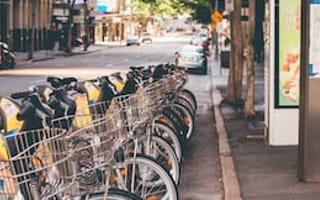If you have plans after work tonight, you’re probably looking for new transportation options. After Prop 1 failed on Saturday, Uber and Lyft announced they would shut down their ridesharing services in Austin this morning.
Uber and Lyft have only been in Austin for two years, and while they’ll likely return, there are other ways to get around. In fact, some organizations stand to benefit without them here. Here are the top five that come to mind.

5. Employers with bike rooms
Maybe the people who are motivated enough to bike to work are already doing it, and the rest of us will need more than TNCs leaving town to commit to cycling.
Still, we did just lose two popular options for alternative commuting. That means more of us will fall back on using our cars, which means more demand for parking — a commodity whose supply is already so constrained downtown that many companies reward employees with cash just to find a way to not need it.
 So far, the most common and effective approach seems to be leaving room for bikes, showers and locker rooms in an office design, the way
So far, the most common and effective approach seems to be leaving room for bikes, showers and locker rooms in an office design, the way

4. Carsharing services
Car2Go and Zipcar aren’t right for every situation, especially a ride home after last call. But with dedicated — and highly coveted — parking spots all over downtown, many of us may give carsharing a second look.
Gas is included with both services, and Car2Go lets you park almost anywhere for free — and, importantly, drop off the vehicle at your destination when you’re done with it.

3. Local delivery services
Austin-based
is a courier service for e-commerce businesses looking for a painless way to make local deliveries, which is the game Uber was actually born to play (ridesharing was just its way of recruiting an army of drivers and building a fleet of vehicles). The two companies may compete in other markets as Dropoff grows, but for now the streets of Austin just got a lot less crowded. And of course there’s
And of course there’s

2. Ride finding apps
is part of the moovel family of apps that are trying to deliver the one-stop tool for getting around that urbanites have been waiting for all these years. In a city, you have a lot of options for getting around, and there’s no one best answer all the time.The ideal situation is one that uses APIs and integrations to let you compare your options based on your location, the location of your next calendar event, bike shares, transit routes and arrival times and more.
RideScout itself doesn’t include Capital Metro in its recommendations, but the moovel transit platform does allow transit agencies to access ticketing, including mobile sales, real-time analytics and transaction data. With more Austinites looking for substitute rides, now’s a great time for public transit to get on board.

1. Ridesharing services that collaborate with Austin
Assuming they can work out a few kinks in their app, Get Me is poised to fill the void left by the major players who just left. Their prices are higher, and fewer drivers means longer wait times. But that could change as thousands of local drivers are left looking for fare after Uber and Lyft deactivated their apps this morning.
Importantly, the company has said throughout the Prop 1 debate that it would agree to use fingerprints in background checks for its drivers.
 Much hay has been made over the mysterious identity of the company’s CEO, who speaks through Chief Experience Officer (“CXO”) Jonathan Laramy (pictured right).
Much hay has been made over the mysterious identity of the company’s CEO, who speaks through Chief Experience Officer (“CXO”) Jonathan Laramy (pictured right).
But whomever is in charge, the more interesting question is whether the company will get up to speed fast enough to convert Uber and Lyft customers before their habits change — or the companies negotiate a return to Austin.
Have a news tip for us or know of a company that deserves coverage? Tell us or tweet @BuiltInAustin.









